Research Article
Core Scale analysis on Asphaltene Flocculation Inhibition and Deposits removal by Ultrasonication
Petroleum Engineering Program, Texas A&M University at Qatar, P.O. Box 23874, Doha, Qatar
*Corresponding author: Mahmood Amani, Texas A&M University at Qatar, P.O. Box 23874, Doha, Qatar, Tel: +974-4423-0119, E-mail: amani@tamu.edu
Received: September 29, 2017 Accepted: October 5, 2017 Published: October 11, 2017
Citation: Amani M, Carvero A, Yrac R, Sayed A, Rauf AA. Core Scale Analysis on Asphaltene Flocculation Inhibition and Deposits Removal by Ultrasonication. Int J Petrochem Res. 2017; 1(2): 96-100. doi: 10.18689/ijpr-1000117
Copyright: © 2017 The Author(s). This work is licensed under a Creative Commons Attribution 4.0 International License, which permits unrestricted use, distribution, and reproduction in any medium, provided the original work is properly cited.
Abstract
Asphaltene buildup in the near wellbore region is an increasingly problematic
phenomenon, especially in mature fields. Research on ultrasonic treatment to address
this issue has increased in recent years, with a field trial on mature fields exhibiting
favorable characteristics. Investigation of petrophysical characteristics, precipitation of
asphaltenes in rock samples, employment of ultrasonication to remove/inhibit deposits, investigation of optimum sonication time, and the resultant increase of permeability to
brine and crude oil are discussed and illustrated. Prevention and or removal of asphaltene
deposits inside the wellbore as well as the nearby wellbore region can significantly
improve in the recovery of the petroleum reservoirs.
Keywords: Asphaltene Deposition; Ultrasonic Waves; Enhanced Oil Recovery; Core
Analysis.
Introduction
Asphaltenes are large, complex and polar molecules in petroleum crudes that consist
of aromatic rings with oxygen, nitrogen, or sulfur atoms. They are not soluble in crude
oil, but rather suspended as colloids, which are aggregates of asphaltene stabilized in
the oil by its resin-content. This is due to the fact that resins are also polar components
of the oil and thus can easily be adsorbed on these colloidal particles surfaces. When this
stable condition is disturbed, the asphaltenes form flocs, which are a larger group of
precipitates [1]. In the field, this destabilization occurs during miscible flooding, after
acid stimulation or in mature reservoirs due to the drop in pressure.
The deposition of asphaltenes around the wellbore of oil producing wells can greatly
affect their productivity as asphaltenes-deposition clogs the connected pores around
the well and restricts fluid flow. The severity of asphaltene-deposition depends on the
composition of the crude produced, especially its asphaltene content (which can be as
high as 60%) and the resin-to-asphaltene volume ratios (at which the crude is not stable
for ratios below 1:1) [2].
This deposition is classically treated with the injection of chemicals. The use of
ultrasonic waves can offer a less expensive alternative to address the issue [3]. Other
advantages of the use of sonication for asphaltene deposition treatment (and inhibition) includes better zonal control, to only target wanted intervals, and the ability to perform
stimulation while producing, thus reducing non-productive time. The purpose of this paper is to first describe the methodologies used to determine
porosity, permeability and asphaltene deposition criteria for homogenous rock samples. The results of these are then used to create asphaltene deposition in rock samples and
compare the resultant permeability to earlier results. Sonication is conducted and
permeability is compared again to determine treatment effectiveness.
Methodology
Often questions arise about the reservoir production; how
and of what composition will the reservoir produce. In the oil
and gas industry, reservoir and production engineers face a
challenge when it comes to maximizing the recovery of
hydrocarbons from the reservoir in a very short amount of
time. These various questions can be answered by finding the
phase and volumetric behavior of the hydrocarbons produced
[4]. Porosity and permeability determination forms the basis
of these calculations and crucial answers. In this research, the
same building blocks are used for further testing regarding
asphaltene deposition and sonication on samples.
Sample preparationof the rock-sample cores, is the key for
an organized and successful experimentation. It will give initial
information about the properties of the core sample and will
dictate the flow of the operation. Primary testing was in regards
to determining porosity and permeability of samples. Since every
sample was a smaller segment (two inches in length and one
inch in diameter) of a larger foot-long core sample of the same
rock segment, it was expected that there will be relatively low
levels of variation in permeability and porosity amongst the
smaller individual core samples [7].
As part of obtaining initial information about the core
sample, a porosity test is necessary. The samples tested were
in the same magnitude/range of porosity as highlighted
above. This testing was conducted using a brine saturation
setup that is described further in the section detailing the
procedure used to determine permeability. Calculating the
porosity of the core sample leads to information that is
required to proceed with further testing of permeability, especially with regards to asphaltene deposition [8]. This is of
increased significance since lower porosity implieshigher fluid
inlet pressure. High inlet pressure permeability can be time
consuming and hazardous.
It is the sole purpose of the project to see the impact of
applying ultrasonic waves on a sample, which has asphaltene
deposition. One of the method that was used to serve the
purpose was by testing the permeability of the sample. Core
sample after having been flooded with heptane and crude oil
was tested before and after subjecting the sample into an
ultrasonication for a predetermined time with permeability to
evaluate the effect of the treatment used.
Procedure
Sample Preparation
a. Indiana Limestone samples that were obtained at
1-foot in diameter were cut intocore samples 2 inches
in length.
b. Samples were weighed, cleaned and sequentially
arranged in order to remain within homogenous
limits of the original limestone sample. Porosity Determination
c. Core samples were dried in an oven at 80 degrees
Celsius overnight.
d. After the drying process, the sampleswere re-weighed
as W1.
e. The weighed samples were then stored in a cell under
vacuum.
f. After 8 hours under vacuum, the cores were then
saturated with 2% solids by weight brine solution
overnight, in a setup demonstrated in Figure 1.
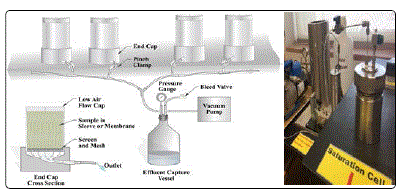
Figure 1. Brine Saturation Setup
g. At the end of the saturation cycle, the cores were
harvested and re-weighed as W2.
h. Porosity was then calculated using: % Porosity = ((W2-W1)/W2)*100
i. Initial Porosity results are shown in Table 1.
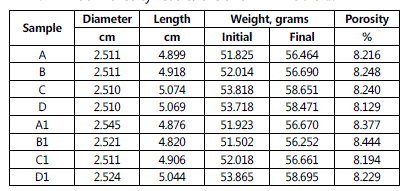
Table 1. Core Dimensions and Initial Porosity Results
Permeability Determination
j. Core samples of 1 inch in diameter and 2 inches in
length, which were previously saturated with 2% brine
solution was placed inside the core holder of the
Pore-Core scale flooding setup illustrated and shown
in Figure 2
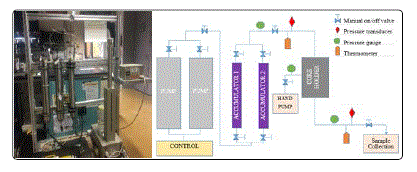
Figure 2. Pore-Core Scale Flooding Actual Setup
k. The cores were then flooded with 2% solids by weight brine solution to get the permeability to brine of the samples. Pressure inlet and pressure outlet values were monitored using a commercially available software apparatus demonstrated in Figure 3

Figure 3. Permeability Monitoring and Measuring Software
Asphaltene Deposition
1. The cores were then flooded with Heptane and crude oil
to develop asphaltene deposition in the core samples.
2. After setting the core samples overnight inside the core
holder, permeability determination using crude oil was
done on the core samples before sonication as an initial
permeability value before sonication.
Sonication
a. The core samples were then taken out of the core
holder to be subjected to sonication. Four samples
from each relatively homogenous set
wereselectedto undergo different sonication
durations, which were 2.5, 5, 7.5 and 10 minutes. Sonication time was up to 10 minutes and at
90% of maximum amplitude (with 1.8 sonotrod
booster) to protect the ultrasonic machine from
overheating and ultimately being damaged.
b. After the sonic ation, the core samples werethen
replaced inside the core holder for post-sonication
permeability testing with crude oil as final, treated
permeabilities.
Results and Discussion
To provide some background and to understand where the obtained results fall in the grand scheme of oil production, the following discussion is presented. In a reservoir, there are various properties that affect how we can successfully produce hydrocarbons from the formation. Some properties, including temperature, pressure, and volume, differ in every reservoir. Knowing these properties helps us understand how our fluid will go ahead and flow through the reservoir and it helps us "evaluate reserves and to develop the optimum recovery plan" [3].
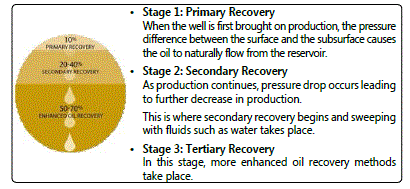
Figure 4. Three Stages of Oil Recovery
Through this experimental set-up, tertiary recovery was
the ultimate objective. The tertiary, also known as enhanced
oil recovery promotes different kind of processes wherein 50-
70% of the remaining oil in place can be recovered. Preventing
asphaltene deposition in the tubing and the near wellbore
region can be very helpful in obtaining this additional
recovery. Recent research has demonstrated that ultrasonic
technology has been emerging as a remarkable option based
on its effectiveness and ease of employment [5].
The results of permeability to brine before and after
sonication is detailed in Table 2. No decrease or increase in
permeability was observed in ~40% of sonicated samples. Figure 5 & 6 detail initial permeability values for two sets of
core samples described in the methodology section.

Table 2. Brine Permeability Before and After Sonication, and Impact Percentage
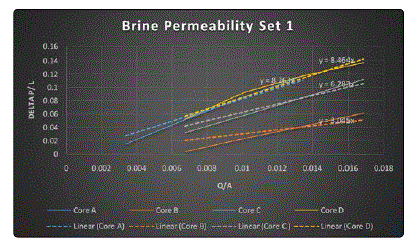
Figure 5. Initial Permeability Indication by Brine of Core Samples Set 1 (A, B, C and D)
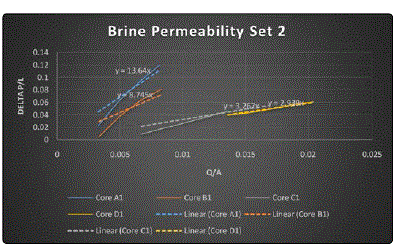
Figure 6. Initial Permeability Indication by Brine of Core Samples Set 2 (A1, B1, C1& D1)
The brine permeability test for the core sample serves as an initial permeability indication to be used later in calculations to gauge the impact of ultrasonic treatment of the asphaltene deposits. After obtaining results from the first set of core samples (Set 1) similar tests on a second set of core samples (Set 2) were done for verification purposes.
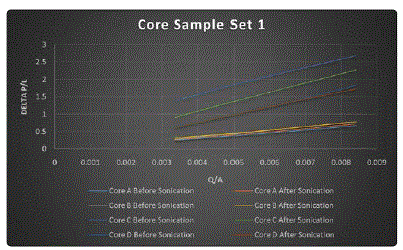
Figure 7. Secondary Permeability Results on Core Samples Set 1 (A, B, C and D)
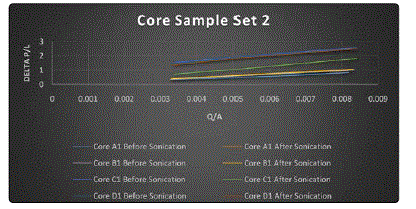
Figure 8. Secondary Permeability Results on Core Samples Set 2 (A1, B1, C1 and D1)
Figures 7 & 8 show the permeability curves of samples Set 1 and Set 2 with the impact caused by ultrasonic treatment on core samples with asphaltene deposition. This is the postsonication permeability and follows the same trend for both sets and pre-sonication permeability ranges. This highlights no erroneous outliers and homogeneity of the larger rock sample. Figure 9 also demonstrates the post-sonication permeability impacts for both sample sets.
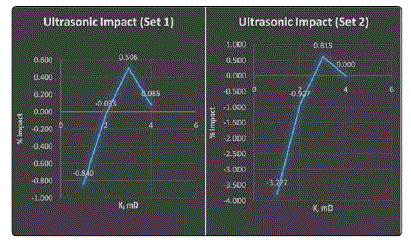
Figure 9. Post-Sonication Permeability Impacts for both Sample Sets
Conclusions
• A downhole method for ultrasonic treatment can be
helpful to enhance oil recovery on failing oil wells. • This method increases the permeability of the bottom
hole zone and reduces blockages.
• This method is simple, and environmentally safe
• The effect due to ultrasonic treatment can last for few
months. According to Vladimir et al. this affect can last
3-12 months [6].
• It was observed that at 7.5 minutes of sonication time
permeability increase was at the highest levels in relation
to higher and lower exposure times for both sets of core
samples, demonstrated by core samples C.
• A trend can be drawn from the results obtained in the
post-sonicationpermeability test for both homogeneity
samples (Set1 and Set 2).
• Core samples were not uniform with respect to brine
permeability. The displacement of brine in the sample
verified the flow assurance of liquid, monitored entirely
by a commercially available software, also used for
permeability investigations with crude oil.
• Core samples with low permeability are difficult to test as
inlet pressures are high and time consuming. The highest
rate of impact was recorded in core samples C which are
0.506 and 0.615 corresponding to 27.6%-62% increase in
oil recovered after sonication.
Acknowledgment
This publication was made possible by an NPRP award
[NPRP 5 - 352 - 2 - 137] from the Qatar National Research
Fund (a member of The Qatar Foundation). The statements
made herein are solely the responsibility of the authors.
Conflict of Interest
The authors confirm that there is no conflicts of interest regarding this manuscript.
References
- Amani M, Retnanto A. AlJuhani S, Al-Jubouri M, Shehada S, Yrac R. Investigating the Role of Ultrasonic Wave Technology as an Asphaltene Flocculation Inhibitor, an Experimental Study. International Petroleum Technology Conference, doha, Qatar 2015. doi: 10.2523/IPTC-18473-MS
- Gollapudi UK, Bang SS, Islam MR. Ultrasonic Treatment for Removal of Asphaltene Deposits During Petroleum Production. In SPE Formation Damage Control Symposium, Lafayette, Louisiana, USA. Society of Petroleum Engineers. 1994. doi: 10.2118/27377-MS
- Danes A. Developments in Petroleum Science. In PVT and Phase Behavior of Petroleum Reservoir Fluids. Els Sci. 1998; first edition Chapter. 47.
- Freyss H, Guieze P, Varotsis N, Khakoo A, Lestelle K, Simper D. PVT Analysis for Oil Reservoirs. Reservoir Engineering. Schlumberger. 1989; 37(1): 4-15.
- Calibration. Schlumberger Oilfield Glossary. Retrieved online. 2017.
- Vladimir OA, Marat SM, Abramova VA, Esipov IB, Mason TJ. Ultrasonic Technology for Enhanced Oil Recovery from Failing Oil Wells and the Equipment for its Implementation. Ultrason Sonochem. 2013; 20(5): 1289-1295. doi: 10.1016/j.ultsonch.2013.03.004
- Najafi I, Amani M. Asphaltene Flocculation Inhibition with Ultrasonic Wave Radiation: A Detailed Experimental Study of the Governing Mechanisms. Advances in Petroleum Exploration and Development. 2011; 2(2): 32-36.
- Najafi I, Mousavi S, Ghazanfari MR, Ghotbi MHC, Ramazani A, Kharrat R, Amani M. Quantifying the Role of Ultrasonic Wave Radiation on Kinetics of Asphaltene Aggregation in a Toluene-Pentane Mixture. Petroleum Science and Technology. 2011; 29(9): 966-974. doi: 10.1080/10916460903394144



